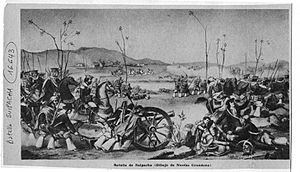Battle of Suipacha facts for kids
Quick facts for kids Battle of Suipacha |
|||||||
|---|---|---|---|---|---|---|---|
| Part of Bolivian War of Independence Argentine War of Independence |
|||||||
 Detail of a lithography of the battle |
|||||||
|
|||||||
| Belligerents | |||||||
| Commanders and leaders | |||||||
| Strength | |||||||
| 600 10 field guns |
800 4 field guns |
||||||
The Battle of Suipacha was an important fight that happened on November 7, 1810. It took place in what is now Bolivia. Back then, this area was known as Upper Peru (or Alto Perú).
This battle was part of the Bolivian War of Independence and the Argentine War of Independence. It was fought between the Spanish colonial army and the forces from Buenos Aires. These forces were sent by the Primera Junta, which was the first government of Argentina.
The Battle of Suipacha was the first big win for the independence fighters against the Spanish. It happened about 25 kilometers (15 miles) southeast of Tupiza. The battle was near the small town of Suipacha, by the Suipacha River.
Why the Battle Happened
Before this battle, in 1809, there was a rebellion in Upper Peru. Spanish forces, led by Generals Vicente Nieto and José de Córdoba y Rojas, stopped this rebellion. This meant Spain was still in control of the region.
Then, in May 1810, the May Revolution happened in Buenos Aires. This led to the creation of the Primera Junta. The new government decided to send an army to Upper Peru.
This army was led by Antonio González Balcarce. Their job was to check out the area and see what was happening. As they marched from Buenos Aires, more and more volunteers joined them.
One important group of volunteers were gauchos, led by Martín Miguel de Güemes. He later became a very important leader in the fight for independence. By the time the army reached Upper Peru, it had about 600 men and 10 cannons.
A Quick Victory
Before Suipacha, the independence forces had a small fight at Cotagaita on October 27. They were pushed back there. After that, they moved to the south bank of the Suipacha River, near the town of Nazareno.
The Spanish forces then got more soldiers. They attacked the independence army with about 800 men and 2 cannons. But the independence fighters fought back strongly. They attacked the Spanish on their left side.
This surprise attack caused the Spanish to retreat. The independence forces then attacked the Spanish camp. This made the Spanish army pull back completely. The whole battle lasted only about 30 minutes!
This victory was very important. After the battle, many people in Upper Peru rose up against Spanish rule. The Spanish Governor, Francisco de Paula Sanz, was captured in Potosi. Spanish Generals Nieto and Córdoba also faced serious consequences. The independence army then kept moving north.
What Happened Next
The win at Suipacha made everyone feel much more hopeful. There were big celebrations in Potosí on November 10. In Buenos Aires, the government gave special armbands to all the soldiers who fought. These armbands said, "The homeland to the victors of Tupiza."
From a political side, this battle was a huge success. It helped the independence forces control most of the former Viceroyalty of the Río de la Plata for a long time.
Today, the 2nd Infantry Regiment of the Argentine Army still wears a special patch on their uniforms. This patch honors the victory at Tupiza.
See also
 In Spanish: Batalla de Suipacha para niños
In Spanish: Batalla de Suipacha para niños

